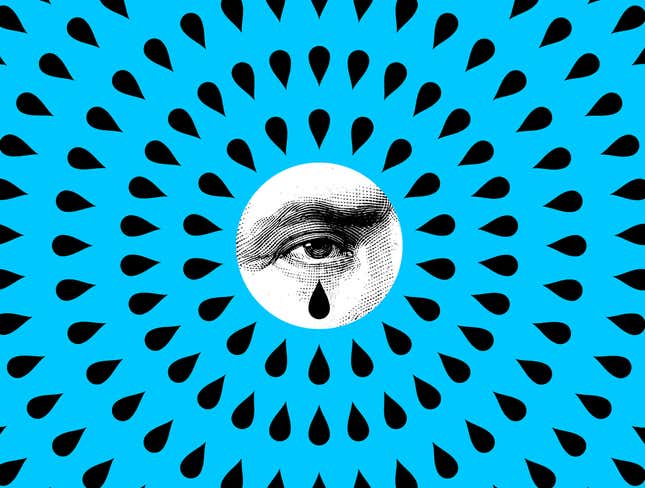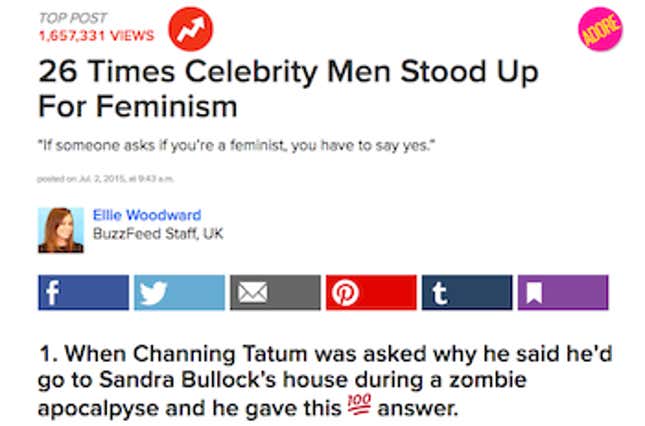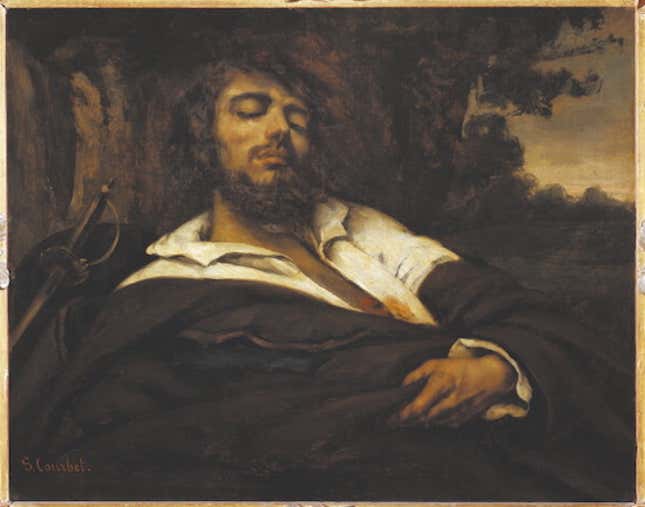
A few weeks ago Matt McGorry, actor and male feminist du jour, shared a photo of himself crying. “Who needs bravado when you’ve got vulnerability? Being a ‘real man’ is being true to yourself,” McGorry wrote in the accompanying tweet. Hashtagged #FindYourMagic, McGorry’s tears were manufactured for a new Axe campaign.
Axe and its European iteration Lynx are best known for their hyper-masculine ads, crafted to promote scents that were designed to be aggressive, assaulting unsuspecting olfactory nerves with the potent smell of manliness. The Axe brand eventually became somewhat of a punchline, and as such, the company has recently tried to change its image. Their new campaign, titled Find Your Magic, is an eager attempt to shed its reputation as the soap of choice for bros who loved I Hope They Serve Beer in Hell. Instead of lauding hard abs and hot women, Axe’s rebranding attempts to serve up a new kind of masculinity—a kind that prioritizes authentic individuality and expression over overt power and straight seduction. “Who needs a six-pack?” the voiceover in a social media-focused Lynx campaign asks, emphasizing that the new masculinity is better defined by abstract concepts like “protest,” “moves,” and, most importantly, “feeling.”
The campaign, an ad executive told Adweek, is an attempt to “liberate guys from pressure and bullshit.” Though the connection between liberation, empowerment, and consumption is spurious to its core, the signal of Axe’s rebranding campaign comes through clearly enough: the era of the hyper-masculine bro is dead. Performative vulnerability is in. Even Tucker Max has been converted.
Drafting McGorry for this campaign was perhaps a stroke of genius. The Orange is the New Black and How to Get Away With Murder star is the prototype of vulnerable masculinity in the twenty-teens: he is sensitive, is unafraid to publicly express his feelings, is a feminist, reads the right books (we know because he Instagrams them) and has the right politics. He knows the right words and concepts; he can and will tell you all about intersectionality, for one. McGorry’s Twitter and Instagram feed create a tightly constructed narrative that reiterates, over and over, that he “gets it.” His particular display of vulnerability—shedding tears over the ghost of brands past—signifies that he’s a male feminist, perhaps the epitome of a “male feminist,” in that his very woke tears are a branding tool for Axe.

And McGorry isn’t alone. Pop culture is flooded with vulnerable men, particularly of the celebrity variety. They usually—and vocally—feel an affinity for things like Bernie Sanders, social justice, the environment, and their mom. You’ll find them on lists like “26 Times Celebrity Men Stood Up For Feminism.” This vulnerable masculinity resembles “traditional” masculinity most strongly in the way it’s a consciously rendered performance, one that fits with contemporary mores. It purports to balance strength, that age-old requirement, with gendered softness. These men cry without being weak; they are vulnerable without being penetrable; it’s an iteration of masculinity that draws on the benefits of feeling without being subject to the gendered critique of emotional expression.
With this new masculinity, Chris Pine can weep at the Oscars and still helm a major action franchise; Drake’s self-aware sensitivity cuts to the core yet he’s still sexually potent; Wil Wheaton posts expressive black and white selfies, captioned with descriptions like “Moody,” and yet remains the hero of fanboys; Mark Ruffalo contemplatively stares into the distance, signifying emotional depth, but he’s still Bruce Banner; John Boehner can openly weep. Once celebrated for his authenticity, the vulnerable, crying man is now financially viable. It’s an elaborate performance deeply tied to the market; tears are manufactured for the brand they best serve.
The publicly vulnerable man isn’t exactly new. He is, unsurprisingly, an invention of the theater. Birthed by Shakespeare, the word “vulnerable” first appearance in the final act of Macbeth (1605). Macbeth, who has murdered nearly every character in the play, uses the word as a sort of “your mom” taunt in his final battle with Macduff. “Let fall thy blade on vulnerable crests,” Macbeth says. “I bear a charmed life which must not yield to one of a woman born.”
Despite his “charmed life,” Macbeth is politically spent by the time he’s saying this. His kingdom is adrift; he’s friendless. He’s finally offed a few pages later. Shakespeare’s first use of the word set a precedent for its loaded, uneasy implications: “vulnerable” is an insult that men would throw when their own grasp on power was uncertain in itself.
But for centuries, the idea of vulnerability was separable from what we now think of as vulnerability’s natural expression: weeping and crying. These actions were not always linked to the physically vulnerable, politically at-risk man. In fact, weeping men were very much a part of a public culture well until the mid-nineteenth century.
In her essay “What Happened to the Manly Art of the Noble Weep?” Sandra Newman traces this long, damp history of male tears. From Homer’s Illiad and well throughout the eighteenth century, men publicly cried over politics, religion and romance. “How good are the tears, how sweet the dirges, I would rather sing dirges than eat or drink,” Euripides wrote in The Trojan Women (415 BCE), making clear that crying was more pleasurable than an indulgent feast.
Then, beyond the ancients, religious ecstasy provided another good reason for men to cry. The vulnerable male body was of central importance to the Catholic Church: the flesh “profits nothing,” and the male body, broken and pierced, was the primary site of divine reflection. St. Augustine spilled tears of confession and religious enlightenment; medieval knights displayed authentic tears as part of elaborate courting rituals. As Newman points out, no one thought the tears of playboy-turned-saint Augustine were emasculating. Rather they were evidence of true religious conviction. For at least a couple of centuries, everyone agreed: as long as men wept authentic tears, then they were welcome to do so.

Crying, then, was part and parcel of an accepted performance of masculinity. Changing definitions of gender—ever slippery as they are—determined the person, place or things that could prompt a manly tear. If religion, music and love were longstanding, accepted sites of weepy expression, then by the eighteenth century, poetry and nature were added to the catalogue too. The Romantic poets and painters were epic weepers; they seemed to cry at nearly everything, from death to slightly dilapidated abbeys. In fact, William Wordsworth, John Keats, and Percy Bysshe Shelly wrote with a kind of soulful longing about their tears; mournful expression was valued as a great interpretation of the sensitive poet’s soul, and, in the cult of sensibility, vulnerability reigned supreme.
In one of Wordsworth’s earliest poems, “On Seeing Miss Helen Maria Williams Weep at a Tale of Distress (1786),” he recounts his broody, rhyming delight at witnessing the tears of another:
She wept.—Life’s purple tide began to flow
In languid streams through every thrilling vein;
Dim were my swimming eyes—my pulse beat slow,
And my full heart was swell’d to dear delicious pain.
“Delicious pain,” is a resonate phrase. It could practically be the cri de coeur of the Romantics, artists who believed that sensibility and suffering were themselves heroic. Wordsworth’s eyes welled at the very witness of pain while Keats conjured up the “wakeful anguish of the soul,” like manna from heaven’s “weeping cloud.” Shelly, meanwhile, mourned the death of Keats by ordering “melancholy Mother,” to “wake and weep,” while simultaneously cursing “invulnerable nothings... like corpses in a charnel.”

As male artists became more and more committed to tearful reflections, vulnerability extended beyond watery eyes and emotional display. The body, like the soul, was subsequently made overtly penetrable. In his 1844 self portrait, the French Realist Gustave Courbet depicts himself wounded by a sword, bleeding, suspended somewhere between sleep and death. Here is the vulnerable male artist in all of his proverbial glory: emotionally injured and dripping in blood, his vulnerability authenticates his artistic identity. Vulnerability reaffirmed the male artist’s ability to move back and forth between intellect and emotion without being beholden to either; it reified an old notion that art was a man’s game.
At the time, Courbet’s overdetermined depiction may have marked the temporary death knell of the outwardly vulnerable man, as the Victorians would soon ask for propriety in the public sphere. The Victorians allowed male tears in private, in their valued domestic spaces; they also remained deeply invested in sentimentality, permitting men to shed tears of moral feeling. A male critic could weep over moral lessons drawn from Charles Dickens’ Old Curiosity Shop and a judge could famously cry while listening to testimonies of grisly murders or sentencing a young woman to death. But ultimately, the Victorian era would neatly connect crying with the unnecessary expression of emotion.
Prior to the intervention of Charles Darwin, the outward expression of feeling had been believed to be a divine gift—a higher expression of the soul that self-evidently separated man from animal. In Darwin’s hands, however, crying, like all emotion, was merely part of the evolutionary process, a natural development of communication. Darwin’s “philosophy of weeping,” which he wrote about in The Expression of the Emotions in Man and Animal (1872), suggested that tears were the leftovers of an inherited habit—something that was useful to infants and our ancestors, but served no real purpose for modern adults.
“Englishmen rarely cry, except under the pressure of the acutest grief; whereas in some parts of the Continent the men shed tears much more readily and freely,” Darwin wrote. Crying, then, was for women, babies, and the French. By the end of the nineteenth century, vulnerability wasn’t a question of culture, it was one of biology.
In turn, industrialism seized on and exploited the unemotional man. Mid-nineteenth century factory managers encouraged their employees to quit the with crying; strong and robust men, after all, increased productivity. “The new manliness,” Tom Lutz writes in his Crying: The Natural and Cultural History of Tears, “encouraged men to curb their emotional expression.” Unblushing, heterosexual masculinity was useful for both corporate profit and the decades of combat that would follow the Industrial Revolution. The poet of sensibility gave way to some of the most enduring stereotypes of masculinity: the rugged hyper-individualist, the alienated writer, and the emotionally repressed marketplace man. The great irony, of course, is that Don Draper is his own capitalistic invention.
The crying man never truly disappeared; he just became subject to market forces and scripts of gender that regulated his excess. Sure, a man could cry over death or a football game, but the tears were subject to a Protestant ethic of gentlemanly restraint. Those who showed too much vulnerable emotion—particularly over the wrong things—were subject to censure, a means of hemming in the ever-shifting, ever-important boundaries of gender.
In 2007, these boundaries were tested virally when Chris Crocker posted his “Leave Britney Alone!” video on YouTube. In the video, Crocker, a self-described “sobbing teen lady,” engages in a semi-satirical performance in which he melodramatically defends Britney Spears’ disastrous MTV Music Awards performance. Replete with mascara-filled tears and theatrical delivery, Crocker’s video was purposefully unmasculine—so much so that its parodic intent was seemingly lost on a large portion of the internet.
One newspaper compared the “narcissism” of Crocker’s video with the “self-gratification on the scale of an armed sociopath walking onto a campus.” Leave Britney Alone had crossed a digital line of sorts: Crocker’s excess was offensive because of what it rejected. His self-conscious performance seemed to engage with an artistic subculture that valued the subversiveness of queer (male) vulnerability, while mocking the language of male fandom, whose strict code positions true loyalty as something that shows up mainly in intricate, often arbitrary knowledge of a subject. Men, this code says, show appreciation in the “rational” display of encyclopedic knowledge rather than “irrational” feeling.
Later on, the good cry Michael Jordan had at his 2009 induction into the Basketball Hall of Fame also went viral. The moment, captured in all of its weepy excess by AP photographer Stephen Savoia, was perfect for an online atmosphere engaged in an ambiguous exploration of masculinity, excess and vulnerability—one that would both celebrate and be deeply embarrassed by Crying Jordan, and has continued to do both for years. Part of the humor perpetually elicited by Crying Jordan is a transgression of boundaries. Men are generally allowed to cry about sports, but there is a kind of restraint expected in both fan and athlete, admirer and admired.
Crying Jordan has subsequently been turned into countless gifs, his head superimposed on nearly anyone who has massively and publicly messed up. The comedy is in the indulgence: too many tears, too much emotion, and too much embarrassment.
Photographer Sam Taylor-Wood’s series, Crying Men (2002-04), offered a parallel examination of these dynamics in a set of tightly focused and framed images of male celebrities crying. Laurence Fishburne, Daniel Craig, and Robin Williams all sat for Taylor-Wood’s camera, teasing out the dichotomy between the “artifice inherent in acting and the release of what is inside all of us.” Critics struggled with Taylor-Wood’s series, unsure of what to make of such a close examination of male vulnerability. An uncertain critic wrote in the Telegraph:
They show us people in whom popular culture has come to invest an almost saint-like significance. These men are icons, worshipped by many for their talent, their looks, their success. Partly because of their fame, they have gained a meaning beyond their physical presence.
Reduced to tears, their grief has an authority we would not necessarily grant to anonymous individuals. With her stark and simple images, Taylor-Wood is seeking to bestow on her sitters a spiritual significance born of their celebrity, akin to that of the crying saints in Medieval and Renaissance art.
Unable to make sense of modern masculine men openly weeping, the Telegraph critic resorts to history, to crying saints, whose vulnerability seems authentic and appropriate. It’s a strange capitulation to history—a return to the idea that emotional and physical vulnerability could be inherently separated, and needed to be, at that. The truth is, as Taylor-Wood’s project acknowledged implicitly, that grief and sadness are universal. Nonetheless, male tears are perpetually read as transgressive: we interpret emotion based on the identity of the body that weeps.
In the twenty-first century, we explore male vulnerability in twenty-first-century ways. Thinkpieces and videos ask no one in particular, “What Makes Men Cry?” More recently, pop psychology and scientific journals have dedicated a sizable number of words to decoding male tears. Crying, some studies suggest, is not just good for the soul, but leads to longer, healthier lives (perhaps unsurprisingly, the 19th century saw a spate of scientific studies concerning the physical benefit of male tears as well).
These pieces are haunted by a phantom—the “real man” who never cries. These paragons of masculinity, the narrative goes, are in need of some emotional release; buying into stereotypes frays at their psyche and hurts their health. But this script can’t be rewritten with dispassionate medical advice; such a massive edit requires a familiar point of departure. Thus, in the language of the Internet, simple actions like manly tears became heroic, and sexualized. Crying men were recast from “wuss” to “badass,” and shedding a few tears could help a bro get laid. Gender, tears, and vulnerability thus found its necessary semantic bridge in sexual heroism: what was “woke,” in other words, was automatically “bae.”
There’s a certain unconvincing posturing in all of these arguments. Crying is inevitably framed as an iconoclastic, damn the man, tear down the establishment kind of act. Yet the crying men ask to retain their establishment potency; they ask for their emotional expression to be seen not as mundane, but heroic. And so traditional masculinity remains both a straw man and an unchallenged, ahistorical script. Queerness and gender fluidity still have no place in the celebration of male tears. The new masculinity shows solidarity with nothing but itself.
Where does this leave women? Women are allowed to cry, the narrative goes—and men should be granted the same cultural permission. But this isn’t exactly true. Women are not allowed to cry as much as they are expected to cry; to be ruled by an excess of emotion and governed by irrational expression rather than rational ideas. The stereotypes are familiar: crazy ex-girlfriends, trainwrecks, the hot mess. Women’s crying is still tethered to its stigmas and stereotypes; men’s tears get to remake themselves, combining vulnerability and potency in ways that are continually validated, continually new. Male tears have been constructed to survive their own critique.
As male tears abound, it seems worth asking, for whom exactly is the renegotiation of the publicly vulnerable man for?
If, as historians of emotions have argued, that the stereotype of the stoic, tearless man was an invention of capitalism, created for the purpose of lining the pockets of industrial tycoons and underpinned by nationalism, then who does the new vulnerability serve? Perhaps some idea of authentic individuality, which is, not coincidentally, what brands want right now too. Matt McGorry’s teary tweet—his performance of a vulnerable “real man”—was done for the sake of giving Axe a makeover. Which came first, brand or tears, is hard to say. What exactly is “real” about the new vulnerable “real man” is even harder to identify.
Nonetheless, the model is solidifying. Earlier this month, Vanity Fair jokingly labeled male tears the “hottest trend in movies.” The New Yorker celebrated the vulnerable masculinity depicted on Outlander and The Americans. The script of manhood is being rewritten. Male tears are no longer the mockable stuff of ironic misandry: for the first time ever, masculine vulnerability has the power to sell on a large capitalist scale.
Illustration by Jim Cooke